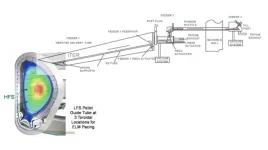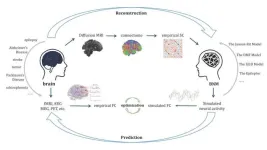Since the 1950s, a chemotherapy drug known as 5-fluorouracil has been used to treat many types of cancer, including blood cancers and cancers of the digestive tract.
Doctors have long believed that this drug works by damaging the building blocks of DNA. However, a new study from MIT has found that in cancers of the colon and other gastrointestinal cancers, it actually kills cells by interfering with RNA synthesis.
The findings could have a significant effect on how doctors treat many cancer patients. Usually, 5-fluorouracil is given in combination with chemotherapy drugs that damage DNA, but the new study found that for colon cancer, this combination does not achieve the synergistic effects that were hoped for. Instead, combining 5-FU with drugs that affect RNA synthesis could make it more effective in patients with GI cancers, the researchers say.
“Our work is the most definitive study to date showing that RNA incorporation of the drug, leading to an RNA damage response, is responsible for how the drug works in GI cancers,” says Michael Yaffe, a David H. Koch Professor of Science at MIT, the director of the MIT Center for Precision Cancer Medicine, and a member of MIT’s Koch Institute for Integrative Cancer Research. “Textbooks implicate the DNA effects of the drug as the mechanism in all cancer types, but our data shows that RNA damage is what’s really important for the types of tumors, like GI cancers, where the drug is used clinically.”
Yaffe, the senior author of the new study, hopes to plan clinical trials of 5-fluorouracil with drugs that would enhance its RNA-damaging effects and kill cancer cells more effectively.
Jung-Kuei Chen, a Koch Institute research scientist, and Karl Merrick, a former MIT postdoc, are the lead authors of the paper, which will appear in Cell Reports Medicine.
An unexpected mechanism
Clinicians use 5-fluorouracil (5-FU) as a first-line drug for colon, rectal, and pancreatic cancers. It’s usually given in combination with oxaliplatin or irinotecan, which damage DNA in cancer cells. The combination was thought to be effective because 5-FU can disrupt the synthesis of DNA nucleotides. Without those building blocks, cells with damaged DNA wouldn’t be able to efficiently repair the damage and would undergo cell death.
Yaffe’s lab, which studies cell signaling pathways, wanted to further explore the underlying mechanisms of how these drug combinations preferentially kill cancer cells.
The researchers began by testing 5-FU in combination with oxaliplatin or irinotecan in colon cancer cells grown in the lab. To their surprise, they found that not only were the drugs not synergistic, in many cases they were less effective at killing cancer cells than what one would expect by simply adding together the effects of 5-FU or the DNA-damaging drug given alone.
“One would have expected that these combinations to cause synergistic cancer cell death because you are targeting two different aspects of a shared process: breaking DNA, and making nucleotides,” Yaffe says. “Karl looked at a dozen colon cancer cell lines, and not only were the drugs not synergistic, in most cases they were antagonistic. One drug seemed to be undoing what the other drug was doing.”
Yaffe’s lab then teamed up with Adam Palmer, an assistant professor of pharmacology at the University of North Carolina School of Medicine, who specializes in analyzing data from clinical trials. Palmer’s research group examined data from colon cancer patients who had been on one or more of these drugs and showed that the drugs did not show synergistic effects on survival in most patients.
“This confirmed that when you give these combinations to people, it’s not generally true that the drugs are actually working together in a beneficial way within an individual patient,” Yaffe says. “Instead, it appears that one drug in the combination works well for some patients while another drug in the combination works well in other patients. We just cannot yet predict which drug by itself is best for which patient, so everyone gets the combination.”
These results led the researchers to wonder just how 5-FU was working, if not by disrupting DNA repair. Studies in yeast and mammalian cells had shown that the drug also gets incorporated into RNA nucleotides, but there has been dispute over how much this RNA damage contributes to the drug’s toxic effects on cancer cells.
Inside cells, 5-FU is broken down into two different metabolites. One of these gets incorporated into DNA nucleotides, and other into RNA nucleotides. In studies of colon cancer cells, the researchers found that the metabolite that interferes with RNA was much more effective at killing colon cancer cells than the one that disrupts DNA.
That RNA damage appears to primarily affect ribosomal RNA, a molecule that forms part of the ribosome — a cell organelle responsible for assembling new proteins. If cells can’t form new ribosomes, they can’t produce enough proteins to function. Additionally, the lack of undamaged ribosomal RNA causes cells to destroy a large set of proteins that normally bind up the RNA to make new functional ribosomes.
The researchers are now exploring how this ribosomal RNA damage leads cells to under programmed cell death, or apoptosis. They hypothesize that sensing of the damaged RNAs within cell structures called lysosomes somehow triggers an apoptotic signal.
“My lab is very interested in trying to understand the signaling events during disruption of ribosome biogenesis, particularly in GI cancers and even some ovarian cancers, that cause the cells to die. Somehow, they must be monitoring the quality control of new ribosome synthesis, which somehow is connected to the death pathway machinery,” Yaffe says.
New combinations
The findings suggest that drugs that stimulate ribosome production could work together with 5-FU to make a highly synergistic combination. In their study, the researchers showed that a molecule that inhibits KDM2A, a suppressor of ribosome production, helped to boost the rate of cell death in colon cancer cells treated with 5-FU.
The findings also suggest a possible explanation for why combining 5-FU with a DNA-damaging drug often makes both drugs less effective. Some DNA damaging drugs send a signal to the cell to stop making new ribosomes, which would negate 5-FU’s effect on RNA. A better approach may be to give each drug a few days apart, which would give patients the potential benefits of each drug, without having them cancel each other out.
“Importantly, our data doesn’t say that these combination therapies are wrong. We know they’re effective clinically. It just says that if you adjust how you give these drugs, you could potentially make those therapies even better, with relatively minor changes in the timing of when the drugs are given,” Yaffe says.
He is now hoping to work with collaborators at other institutions to run a phase 2 or 3 clinical trial in which patients receive the drugs on an altered schedule.
“A trial is clearly needed to look for efficacy, but it should be straightforward to initiate because these are already clinically accepted drugs that form the standard of care for GI cancers. All we’re doing is changing the timing with which we give them,” he says.
The researchers also hope that their work could lead to the identification of biomarkers that predict which patients’ tumors will be more susceptible to drug combinations that include 5-FU. One such biomarker could be RNA polymerase I, which is active when cells are producing a lot of ribosomal RNA.
The research was funded by the Damon Runyon Cancer Research Fund, a Ludwig Center at MIT Fellowship, the National Institutes of Health, the Ovarian Cancer Research Fund, the Holloway Foundation, and the STARR Cancer Consortium.
###
Written by Anne Trafton, MIT News
END





